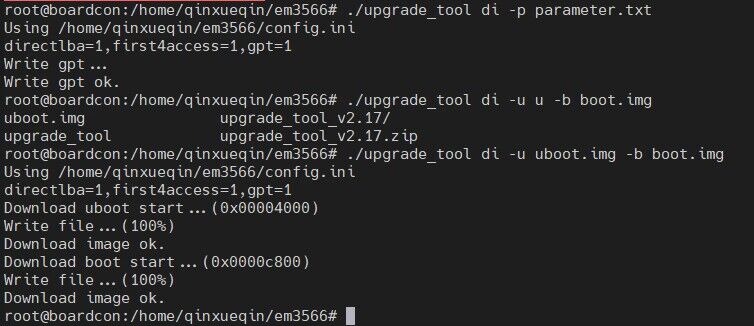1. Execute the commands to reconfig the kernel
# cd kernel
# make ARCH=arm64 menuconfig
2. After reconfig, rename the file kernel\.config to rockchip_linux_defconfig
3. Copy the file kernel\rockchip_linux_defconfig to replace kernel\arch\arm64\configs\rockchip_linux_defconfig
It is recommended to back up the original rockchip_linux_defconfig before replacing.
Products
- +Single board computer
- +Rockchip
- SBC3588 Idea3588 Idea3588S Idea3576 SBC3576 EM3576 SBC3568 EM3568 EM3568-AV CAM SBC3566 EM3566 EM3562 EM3326S Idea1126 EM1126 SBC3399 Idea3399 EM3399 Idea3288 EM3288 EM1808 EM3128 EM1103B SBC1108
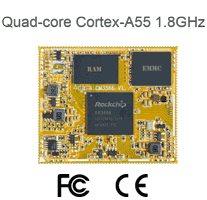
* Processor: Rockchip RK3566. Quad-core Cortex-A55, 1.8GHz
* NPU: 1 TOPS
* RAM: 1GB/2GB/4GB/8GB
* Storage: 8GB/16GB/32GB/64GB/128GB
* Pin out: 5x UART, 2x USB2.0 Host, USB3.0 Host, USB2.0 OTG, LVDS/MIPI DSI, eDP, MIPI CSI, HDMI TX, CIF, GbE, PCIe2.1, 2x SDMMC, I2C, SPI, PWM, ADC, I2S, SPDIF, VOP, GPIO
* Operating system: Android 14, Debian 12, Buildroot
* Dimensions: 47 x 40 mm
* Package: 186-pin, 0.9mm pitch QFN
 Certificate of conformity, Test Report, REACH, ROHS
Certificate of conformity, Test Report, REACH, ROHS
![]() EM3566 Manual
EM3566 Manual
Rockchip RK3566 is a mid-range SoC launched by Rockchip in 2020. It is an upgrade version of the classic RK3288.
The CM3566 is a System-on-Module (SoM) that excels in versatility and power. It is equipped with a 1.8GHz RK3566 Quad-core 64-bit Cortex-A55 processor, a mali-G52 2EE GPU, a high-performance VPU, and 1 TOPS NPU, supporting OpenGL, Vulkan, and 4K video decoding.
This RK3566 module is a powerhouse built for efficiency. One of its standout features is its wealth of expansion interfaces. From high-capacity storage options like PCIe2.1 and SATA3.0 to versatile ports including UART, I2C, and USB 3.0. Its unique 186-pin stamp-hole interface not only makes it easy for customers to use, but also makes your product low cost and fast to market.
The CM3566 adopts a hard high-temperature resistant TG170 PCB, and the core board flatness is controlled under 0.5%.
It has obtained certifications for CE and FCC, and passed the tests including Storage test, Operation Test, Continuous operation test, Vibration test and Drop test.
The CM3566 module has gained many enterprise customers due to its strong and stable performance, and is used in various fields like Sports equipment, Makeup mirror, Smart medical care POCT, e-books, Electronic organ and DJ equipment.
The SoM has been released into mass production.
Boardcon also provides the EM3566 development board and comprehensive documentation to quickly get started with the module and evaluate the solution.
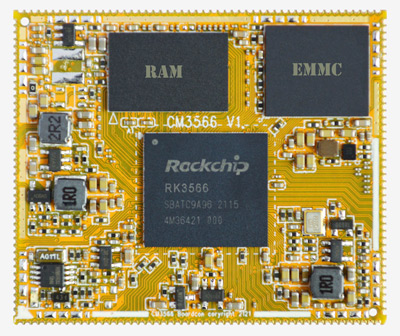
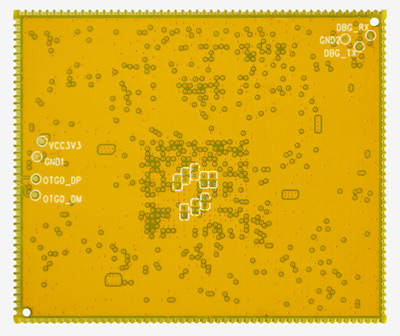
| Specifications | |
|---|---|
| SoC | Rockchip RK3566. Quad-core Cortex-A55 up to 1.8GHz |
| GPU | Mali-G52 GPU. Support OpenGL ES 1.1/2.0/3.2, OpenCL 2.0, Vulkan 1.1 |
| NPU | 1 TOPS |
| Memory | 1GB/2GB/4GB/8GB |
| Storage | 8GB/16GB/32GB/64GB/128GB |
| Supply Voltage | DC 3.3V |
| Pin out | 5x UART, 2x USB2.0 Host, USB3.0 Host, USB2.0 OTG, LVDS/MIPI DSI, eDP, MIPI CSI, HDMI TX, CIF, GbE, PCIe2.1, 2x SDMMC, 2x I2C, 2x SPI, 4x PWM, 3x ADC IN, 2x I2S, SPDIF, VOP, GPIO, etc. |
| Ethernet | Gigabit RGMII (GMAC). If GMAC is not needed, it can be designed to 2x UART and 2x SPI. |
| PCB Layer | 8 |
| Dimensions | 47 x 40 mm |
| Weight | 8.6 gram |
| Package | 186-pin, 0.9mm pitch QFN |
| Application | TV box, AI robot, smart POS machine, e-book, face recognition terminal, business display integrated equipment |
| Development Board | EM3566 |

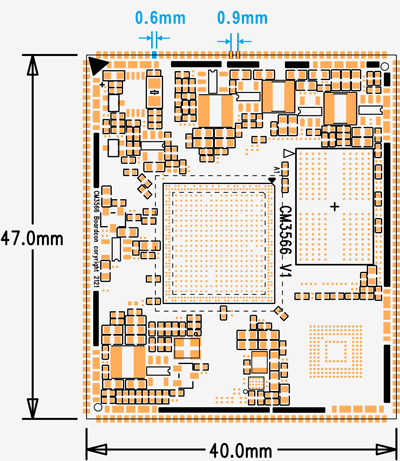

| Pin | Signal | Pin | Signal | Pin | Signal | Pin | Signal |
|---|---|---|---|---|---|---|---|
| 1 | VCC3V3_SYS | 52 | MIPI_CSI_RX_D0N | 94 | UART1_RX_M0 | 145 | SPDIF_TX_M2 |
| 2 | VCC3V3_SYS | 53 | MIPI_CSI_RX_D0P | 95 | UART1_TX_M0 | 146 | GPIO0_A6_d |
| 3 | VCC3V3_SYS | 54 | MIPI_CSI_RX_CLK0N | 96 | UART1_RTSn_M0 | 147 | GPIO0_A3_u |
| 4 | VCC_RTC | 55 | MIPI_CSI_RX_CLK0P | 97 | UART1_CTSn_M0 | 148 | GPIO0_A0_d |
| 5 | PMIC_32KOUT | 56 | GND | 98 | BT_REG_ON_H | 149 | CAMERAF_RST_L |
| 6 | GND | 57 | PWM5 | 99 | BT_WAKE_HOST_H | 150 | CAMERAB_RST_L |
| 7 | HDMITX_CEC_M0 | 58 | LCD_BL_PWM | 100 | HOST_WAKE_BT_H | 151 | CIFT_8BIT_D7 |
| 8 | HDMITX_SDA | 59 | PWM3_IR | 101 | WIFI_WAKE_HOST_H | 152 | CIFT_8BIT_D6 |
| 9 | HDMITX_SCL | 60 | PCIE20_SATA2_RXP | 102 | WIFI_REG_ON_H | 153 | CIFT_8BIT_D5 |
| 10 | GMAC1_RXER_M0* | 61 | PCIE20_SATA2_RXN | 103 | I2S2_SCLK_TX_M0 | 154 | CIFT_8BIT_D4 |
| 11 | GMAC1_MCLKINOUT_M0 | 62 | PCIE20_SATA2_TXN | 104 | I2S2_LRCK_TX_M0 | 155 | CIFT_8BIT_D3 |
| 12 | GND | 63 | PCIE20_SATA2_TXP | 105 | I2S2_SDO_M0 | 156 | CIFT_8BIT_D2 |
| 13 | GMAC1_TXD0_M0 | 64 | PCIE20_REFCLKP | 106 | I2S2_SDI_M0 | 157 | CIFT_8BIT_D1 |
| 14 | GMAC1_TXD1_M0 | 65 | PCIE20_REFCLKN | 107 | SDMMC1_D3 | 158 | CIFT_8BIT_D0 |
| 15 | GMAC1_TXEN_M0 | 66 | USB3_HOST1_SSTXP | 108 | SDMMC1_D2 | 159 | GND |
| 16 | GMAC1_RXDV_CRS_M0 | 67 | USB3_HOST1_SSTXN | 109 | SDMMC1_D1 | 160 | USB2_HOST2_DM |
| 17 | GMAC1_RXD1_M0 | 68 | USB3_HOST1_SSRXP | 110 | SDMMC1_D0 | 161 | USB2_HOST2_DP |
| 18 | GMAC1_RXD0_M0 | 69 | USB3_HOST1_SSRXN | 111 | SDMMC1_CMD | 162 | USB2_HOST3_DP |
| 19 | GMAC1_RXD3_M0 | 70 | USB_OTG0_DM | 112 | SDMMC1_CLK | 163 | USB2_HOST3_DM |
| 20 | GMAC1_RXD2_M0 | 71 | USB_OTG0_DP | 113 | GND | 164 | CIFT_8BIT_VSYNC |
| 21 | GMAC1_RXCLK_M0 | 72 | USB3_HOST1_DP | 114 | SARADC_VIN3 | 165 | CIFT_8BIT_HREF |
| 22 | GMAC1_TXD2_M0 | 73 | USB3_HOST1_DM | 115 | SARADC_VIN2_HP_HOOK | 166 | CIFT_8BIT_CLKIN |
| 23 | GMAC1_TXD3_M0 | 74 | EDP_TX_D2N | 116 | SARADC_VIN0_KEY/ RECOVERY |
167 | GND |
| 24 | GMAC1_TXCLK_M0 | 75 | EDP_TX_D2P | 117 | GND | 168 | CIF_CLKOUT |
| 25 | MIPI_DSI_TX0_D3N/ LVDS_TX0_D3N |
76 | EDP_TX_D1N | 118 | PCIE20_PERSTn_M2 | 169 | VOP_BT656_D7_M1 |
| 26 | MIPI_DSI_TX0_D3P/ LVDS_TX0_D3P |
77 | EDP_TX_D1P | 119 | PCIE20_WAKEn_M2 | 170 | VOP_BT656_D6_M1 |
| 27 | MIPI_DSI_TX0_D2N/ LVDS_TX0_D2N |
78 | EDP_TX_D0N | 120 | PCIE20_CLKREQn_M2 | 171 | VOP_BT656_D5_M1 |
| 28 | MIPI_DSI_TX0_D2P/ LVDS_TX0_D2P |
79 | EDP_TX_D0P | 121 | UART3_RX_M0 | 172 | VOP_BT656_D4_M1 |
| 29 | MIPI_DSI_TX0_D1N/ LVDS_TX0_D1N |
80 | EDP_TX_D3N | 122 | UART3_TX_M0 | 173 | VOP_BT656_D3_M1 |
| 30 | MIPI_DSI_TX0_D1P/ LVDS_TX0_D1P |
81 | EDP_TX_D3P | 123 | UART4_RX_M0 | 174 | VOP_BT656_D2_M1 |
| 31 | MIPI_DSI_TX0_D0N/ LVDS_TX0_D0N |
82 | EDP_TX_AUXN | 124 | UART4_TX_M0 | 175 | VOP_BT656_D1_M1 |
| 32 | MIPI_DSI_TX0_D0P/ LVDS_TX0_D0P |
83 | EDP_TX_AUXP | 125 | I2S1_LRCK_TX_M0_PMIC | 176 | VOP_BT656_D0_M1 |
| 33 | MIPI_DSI_TX0_CLKN/ LVDS_TX0_CLKN |
84 | SDMMC0_DET_L | 126 | I2S1_SDI0_M0/ PDM_SDI0_M0_PMIC |
177 | VOP_BT656_CLK_M1 |
| 34 | MIPI_DSI_TX0_CLKP/ LVDS_TX0_CLKP |
85 | SDMMC0_CLK | 127 | I2S1_SCLK_TX_M0_PMIC | 178 | GPIO4_B5_d_1V8 |
| 35 | HDMI_TX_HPDIN | 86 | GND | 128 | I2S1_SDO0_M0_PMIC | 179 | I2C4_SDA_M0_1V8 |
| 36 | HDMI_TXCLKN | 87 | SDMMC0_CMD | 129 | I2S1_MCLK_M0_PMIC | 180 | I2C4_SCL_M0_1V8 |
| 37 | HDMI_TXCLKP | 88 | SDMMC0_D3 | 130 | GND | 181 | GND |
| 38 | HDMI_TX0N | 89 | SDMMC0_D2 | 131 | SPI0_CS0_M0 | 182 | I2C1_SDA |
| 39 | HDMI_TX0P | 90 | SDMMC0_D1 | 132 | SPI0_MISO_M0 | 183 | I2C1_SCL |
| 40 | HDMI_TX1N | 91 | SDMMC0_D0 | 133 | SPI0_MOSI_M0 | 184 | GPIO0_A5_d |
| 41 | HDMI_TX1P | 92 | USB_OTG0_ID | 134 | SPI0_CLK_M0 | 185 | GMAC1_MDIO_M0 |
| 42 | HDMI_TX2N | 93 | USB_OTG0_VBUSDET | 135 | SPI3_CS0_M1 | 186 | GMAC1_MDC_M0 |
| 43 | HDMI_TX2P | 136 | SPI3_MISO_M1 | ||||
| 44 | MIPI_CSI_RX_CLK1N | 137 | SPI3_MOSI_M1 | ||||
| 45 | MIPI_CSI_RX_CLK1P | 138 | SPI3_CLK_M1 | ||||
| 46 | MIPI_CSI_RX_D3N | 139 | LCD_PWREN_H | ||||
| 47 | MIPI_CSI_RX_D3P | 140 | PWM0_M0 | ||||
| 48 | MIPI_CSI_RX_D2N | 141 | UART5_RX_M1 | ||||
| 49 | MIPI_CSI_RX_D2P | 142 | UART5_TX_M1 | ||||
| 50 | MIPI_CSI_RX_D1P | 143 | UART2DBG_RX | ||||
| 51 | MIPI_CSI_RX_D1N | 144 | UART2DBG_TX | ||||
* pin10: V2 = GND, V3 = GMAC1_RXER_M0
| OS | Item | Feature | Description |
|---|---|---|---|
| Android 14 | Boot | U-Boot 2017.09 | rk356x_spl_loader_v1.23.114.bin |
| Kernel | Version | Linux 6.1.99 | |
| Drivers | eMMC | Support eMMC 5.1 | |
| HDMI | Support 4K, 1080P, 720P, 480P resolution | ||
| Audio | Headphone input/ output | ||
| SD card | Micro SD card | ||
| USB Host | 4x USB2.0 Host | ||
| USB3.0 | USB3.0 Host/SATA3.0 | ||
| Key | Recovery | ||
| USB OTG | USB2.0 OTG | ||
| Ethernet | 10/100/1000 Mbps Ethernet | ||
| Camera | 13 Megapixels, OV13850 model | ||
| WiFi | Wireless-2.4GHz 802.11 b/g/n | ||
| Bluetooth | Bluetooth 4.2 | ||
| 4G&GPS | EC20 LTE | ||
| LCD&TP | 10.1-inch LVDS/MIPI LCD with touch screen | ||
| RTC | HYM8563TS | ||
| Serial port | 2x UART, 1x debug | ||
| RS485 | Support | ||
| Cross-compiler Environment | Ubuntu 22.04/openjdk 11.0.4 | ||
| Debug Tools | SecureCRT, AndroidTool.exe, ADB | ||
| OS | Item | Feature | Description |
|---|---|---|---|
| Debian 12 Buildroot (Linux 6.1) |
Boot | U-Boot 2017.09 | rk356x_spl_loader_v1.23.114.bin |
| Kernel | Version | Linux 6.1.99 | |
| Drivers | eMMC | Support eMMC 5.1 | |
| HDMI | Support 4K, 1080P, 720P, 480P resolution | ||
| Audio | Headphone input/ output | ||
| SD card | Micro SD card | ||
| USB Host | 4x USB2.0 Host | ||
| USB3.0 | USB3.0 Host/SATA3.0 | ||
| Key | Recovery | ||
| USB OTG | USB2.0 OTG | ||
| Ethernet | 10/100/1000 Mbps Ethernet | ||
| Camera | 13 Megapixels, OV13850 model | ||
| WiFi | Wireless-2.4GHz 802.11 b/g/n | ||
| Bluetooth | Bluetooth 4.2 | ||
| 4G&GPS | EC20 LTE | ||
| LCD&TP | 10.1-inch LVDS LCD with touch screen | ||
| RTC | HYM8563TS | ||
| Serial port | 2x UART, 1x debug | ||
| RS485 | Support | ||
| Cross-compiler Environment | Ubuntu 22.04 | ||
| Debug Tools | SecureCRT, AndroidTool.exe, ADB | ||
| OS | Item | Feature | Description |
|---|---|---|---|
| Debian 11 Buildroot (Linux 5.10) |
Boot | U-Boot 2017.09 | rk3566_ddr_1056MHz_v1.17.bin |
| Kernel | Version | Linux 5.10.160 | |
| Drivers | eMMC | Support eMMC 5.1 | |
| HDMI | Support 4K, 1080P, 720P, 480P resolution | ||
| Audio | Headphone input/ output | ||
| SD card | Micro SD card | ||
| USB Host | 4x USB2.0 Host | ||
| USB3.0 | USB3.0 Host/SATA3.0 | ||
| Key | Recovery | ||
| USB OTG | USB2.0 OTG | ||
| Ethernet | 10/100/1000 Mbps Ethernet | ||
| Camera | 13 Megapixels, OV13850 model | ||
| WiFi | Wireless-2.4GHz 802.11 b/g/n | ||
| Bluetooth | Bluetooth 4.2 | ||
| 4G&GPS | EC20 LTE | ||
| LCD&TP | 7-inch/10.1-inch LVDS LCD with touch screen | ||
| RTC | HYM8563TS | ||
| Serial port | 2x UART, 1x debug | ||
| RS485 | Support | ||
| Cross-compiler Environment | Ubuntu 20.04 | ||
| Debug Tools | SecureCRT, AndroidTool.exe, ADB | ||
| Datasheet |
|
|
|
|
| Reference Manual |
|
|
| Tools |
|
|
| Certification |
|
|
|
|
|
|
|
|
If you order the CM3566 SoM or any question, please feel free to contact us at market@armdesigner.com
eg. Switch HDMI to MIPI LCD (Debian11)
Config files path: k356x_linux5.10\kernel\arch\arm64\boot\dts\rockchip\
1. open the file rk3566-evb2-lp4x-v10-linux.dts with an editor. Comment HDMI, uncomment MIPI and save:
//#include "rk3566-evb2-lp4x-v10_hdmi.dtsi"
#include "rk3566-evb2-lp4x-v10_mipi.dtsi"
2. recompile kernel
3. reflash kernel to the board.
I downloaded the source code,when I try to compile, I got this error:
@ubuntu:~/rk356x_linux5.10$ ./build.sh kernel
processing option: kernel
============Start building kernel============
TARGET_ARCH =arm64 TARGET_KERNEL_CONFIG =rockchip_linux_defconfig TARGET_KERNEL_DTS =rk3566-evb2-lp4x-v10-linux TARGET_KERNEL_CONFIG_FRAGMENT =
==========================================
# # No change to .config # CALL scripts/atomic/check-atomics.sh CALL scripts/checksyscalls.sh CHK include/generated/compile.h LZ4C arch/arm64/boot/Image.lz4
Incorrect parameters Usage : lz4 [arg] [input] [output] input : a filename with no FILE, or when FILE is - or stdin, read standard input
Arguments :
-1 : Fast compression (default) -9 : High compression -d : decompression (default for .lz4 extension) -z : force compression -f : overwrite output without prompting -h/-H : display help/long help and exit arch/arm64/boot/Makefile:31: recipe for target 'arch/arm64/boot/Image.lz4' failed make[2]: *** [arch/arm64/boot/Image.lz4] Error 1 make[2]: *** Deleting file 'arch/arm64/boot/Image.lz4' arch/arm64/Makefile:170: recipe for target 'Image.lz4' failed make[1]: *** [Image.lz4] Error 2 make[1]: *** Waiting for unfinished jobs.... arch/arm64/Makefile:214: recipe for target 'rk3566-evb2-lp4x-v10-linux.img' failed make: *** [rk3566-evb2-lp4x-v10-linux.img] Error 2 ERROR: Running build_kernel failed! ERROR: exit code 2 from line 663: make ARCH=$RK_ARCH $RK_KERNEL_DTS.img -j$RK_JOBS
Cause: The version of lz4 delivered with the compilation system is too early.
Solution: update to V1.8.3 or later.
lz4 -v //check the compiler lz4 version
sudo cp out/host/linux-x86/bin/lz4 /usr/bin/lz //copy lz4 from the Android source directory to override the compiler's
Camera does not work properly on board with more than 4GB of memory. After the memory is upgraded from 4GB to 8GB, open the camera APP, the terminal will output:
[ 100.488782] rga_mm: RGA_MMU unsupported Memory larger than 4G! [ 100.488814] rga_mm: scheduler core[4] unsupported mm_flag[0x0]! [ 100.488821] rga_mm: rga_mm_map_buffer map dma_buf error! [ 100.488826] rga_mm: job buffer map failed! [ 100.488831] rga_mm: dst channel map job buffer failed! [ 100.488834] rga_mm: failed to map buffer [ 100.488842] rga_job: rga_job_commit: failed to map job info [ 100.488896] rga_job: request[1] task[0] job_commit failed. [ 100.488909] rga_job: rga request commit failed! [ 100.488915] rga: request[1] submit failed!
Solution: Modify the source code according to the file ddr_than-4G.patch and compile it again.
upgrade_tool is a firmware upgrade tool for Linux. Flash image requires superuser privileges.
1. Download and execute upgrade_tool first.
2. Put the firmware files and upgrade_tool in the same directory.
3. Connect the USB OTG port from the board to your PC, press the recovery button from your board, and connect the power, wait a few seconds and release the button.
4. Use the commands to flash image.
Basic Commands
//List devices upgrade_tool ld //Download boot upgrade_tool db rkxxloader.bin //Flash the partition table upgrade_tool di -p parameter.txt //Flash single partition image upgrade_tool di -k kernel.img //Falsh multiple partition images upgrade_tool di -u uboot.img -b boot.img //Flash the partition image with no defined abbreviation, you need to specify the partition name. //Take the vendor partition as an example upgrade_tool di -vendor vendor.img //When ab partition are used, it also needs to be handled in undefined cases. //Take boot_a and boot_b as example upgrade_tool di -boot_a boot.img -boot_b boot.img //Flash loader and reset upgrade_tool ul rkxxloader.bin //Upgrade firmware and reset upgrade_tool uf update.img //Erase device upgrade_tool ef rkxxloader.bin
